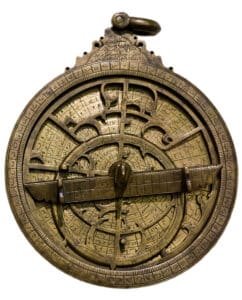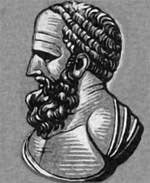While modern humans tend to think of science in terms of innovations made during the past 100 to 200 years, mankind has always had great scientific thinkers. Over 2,000 years ago, one or more such scientific thinkers invented the Astrolabe, a calculator that was capable of solving astronomical problems.
Such a device would have been invaluable to astronomers and, later, with the invention of the maritime Astrolabe, to mariners as well. While traditional Astrolabes, which were known as planispheric astrolabes, calculated the altitude of celestial bodies, the maritime astrolabe was used to determine latitude. Being able to determine latitude was essential to helping mariners know where they were in a featureless ocean or sea.
Quick Facts
- Created
- 6th century
- Creator (person)
- Apollonius
- Original Use
- Capable of working out different types of problems in astronomy.
- Cost
- N/A
Astrolabe: History
The Astrolabe (Greek: ἀστρολάβος astrolabos, from astron (star) and lambanein (to take), i.e. star-taker) is a sophisticated inclinometer (a device used to measure and monitor the incline of an object), used in the past by astronomers, astrologers, and navigators, mainly for locating and predicting the positions of the Sun, Moon, planets, and stars, determining local time given local latitude and vice versa, for triangulation, and surveying. Astrolabe was actually an analog calculator, that measures the altitude of stars and planets above the horizon, capable of working out several different kinds of problems in spherical astronomy.

The Astrolabe was first invented in Portugal between 220 and 150 BC and dates back to Hellenistic civilization. The inventor of the Astrolabe was believed to have been Applonius. The Astrolabe was a hybrid of the planisphere and the dioptra, essentially an analog calculator capable of solving various astronomical problems. Theon of Alexandria wrote a detailed treatise on the Astrolabe, and Lewis contends that Ptolemy made the astronomical observations recorded in the Tetrabiblos using an astrolabe.
The use of Astolable continued widely throughout the Byzantine civilization and was a valuable creation for astronomy and astrology. During this period, John Philponous, a Christian philosopher, wrote a treatise on the Astrolabe in Greek. Severus Sekhbokht later wrote a treatise on Astrolabe in the Syrian language.
The first Renaissance scientific treatises of Astrolabe were based on earlier classical works and were frequently concerned with Ptolemaic doctrines. The most noteworthy of these was the astronomical section of Regiomontanus’ Almanacium, written in 1472.
The use of Astrolabe continued throughout the 17th and 18th centuries. Astronomers and navigators used astrolabes to plot latitude and longitude on charts and marine atlases. They were still used in the 18th century to measure land surfaces like harbors or canals. However, after the introduction of sextants in 1770, the use of astrolabes declined considerably.
Apollonius of Perga (262 BC-190 BC), the great codifier of conic sections, probably studied the astrolabe projection about 225 BC. Apollonius was a Greek geometer and astronomer, whose innovative methodology and terminology, influenced many later scholars including Ptolemy, Johannes Kepler, Isaac Newton, and René Descartes. Apollonius gave the ellipse, the parabola, and the hyperbola their modern names.

The most influential individual in the theory of the astrolabe projection was the Greek astronomer, geographer, and mathematician Hipparchus of Nicaea (190 BC-120 BC). He is considered the founder of trigonometry and the greatest ancient astronomical observer. It is believed, that with an astrolabe Hipparchus was the first to be able to measure the geographical latitude and time by observing fixed stars. Previously this was done in daytime by measuring the shadow cast by a gnomon, by recording the length of the longest day of the year, or with the portable instrument known as a scaphe.
The earliest descriptions of actual astrolabes were written by John Philoponos of Alexandria (c. 490–c. 570) in the sixth century.

There were two basic types of astrolabes. The first type, known as a planispheric astrolabe, helped astronomers calculate the positions of celestial objects. All early astrolabes were of the planispheric sort until seafaring folks saw how useful the instruments could be. Sometimes in the 15th century, maritime astrolabes began appearing, a version of their planispheric cousins, used primarily to determine the altitude of the sun or a star, which could then be used to determine latitude. They came with two basic parts: a graduated circle and an alidade, a sighting device or pointer used to measure angles. Planispheric astrolabes were a bit more complicated and were also more idiosyncratic because their operation depended on the user’s latitude.
The astrolabe was in use until the last half of the 17th century. The invention of the pendulum clock made clocks much more reliable, and more specialized and accurate scientific devices, such as the telescope, became available.
How It Worked
An Astrolabe makes astronomical measurements by altitudes of the celestial bodies of the universe. An astrolabe comprises a deep disc called the mater that holds one or more flat plates called tympan. A tympan is made for a specific latitude which helps denote azimuth and altitude. The mater’s rim is usually graduated in hours, degrees of arc, or both.
Above the mater and tympan, there is a “rete free to rotate.” The best definition of the rete is that it is a component on the Astrolabe with an ecliptic plane projection and several pointers indicating the positions of the brightest stars. These pointers come in various shapes, including balls, stars, hands, dog heads, and leaves, among others. The rete, which represents the sky, serves as a star chart. When it is rotated, the stars and ecliptic move over the coordinate projection on the tympan. A full rotation equates to the passage of a day.
The most crucial element of a traditional astrolabe is a circular plate of metal, usually about 6 inches in diameter, that can be suspended by a ring and hang perfectly vertically. On one side of the disc (the “back”), several circles were engraved with various gradations, such as 360 degrees, 365 1/4 parts for the days, 12 for the months, and so on. Trigonometric calculations could be performed using the engravings. The opposite side of the plate was also engraved. The outer circle was divided into 24 sections for hours. A calendar was created by dividing another circle (zodiacal constellations). The tropics and equator were engraved in the center of the disc, with the celestial pole at the center.
Another disc could be attached to the front of the device and rotated. Many holes were cut into that disc to allow the astronomer to see through to the Astrolabe’s body. These cuts were made to create a map of the sky, which included a broad annulus corresponding to the zodiac (divided by the constellations) and several “tongues” or “flames” pointing to prominent stars. Thin engraved discs or paper could also be used between the sky disc and the astrolabe body.
The instrument and its components measure time and distance by using the shadow cast by the alidade, which is a gnomon. The gnomon casts a shadow from a conical-shaped slot on the circular disk’s edge. This results in an angle equal to the difference between time and altitude for that particular time of day. Because the angle could tell the difference between the times of the day, it helped create birth charts and mark dates. To use Astrolabe for altitude measurement, one had to first determine their latitude.
Historical Significance
Mariner’s Astrolabe
The traditional Astrolabe could not determine the latitude of the ship. Inventors later solved this problem through the development of the mariner’s Astrolabe.
The precise definition of Mariner’s Astrolabe is an inclinometer used to calculate a ship’s latitude at sea by measuring the sun’s noon altitude (declination) or the meridian altitude of a known declination star. Mariners would raise mariner astrolabe such that the sun shined through its two sights. He’d next use the scale to calculate the sun’s altitude and check a table of the sun’s daily declination to calculate his ship’s latitude.
Astronomical Clocks
The Astrolabe also influenced mechanical astronomical clocks. They are the definition of a clockwork astrolabe designed to display the present position of the universe (sun, stars, and planets) in a continuous display. For example, Richard of Wallingford’s clock was essentially an astrolabe with a spinning star chart.
Many astronomical clocks, such as the famous clock in Prague, also use an astrolabe-style display that uses a stereographic projection of the ecliptic plane.
Astrolabes have played a significant role in the past. For instance, it has helped in navigating and creating birth charts. They continue to have an impact today. Astrolabe ideas underpin modern GPS, space science, and navigation technology.
The image featured at the top of this post is ©Sergey Melnikov/Shutterstock.com.

